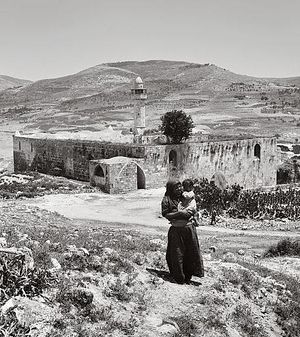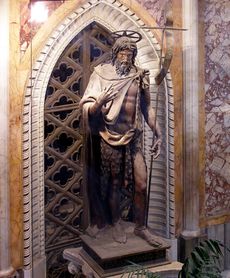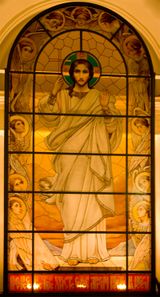يوحنا المعمدان
| يوحنا المعمدان | |
|---|---|
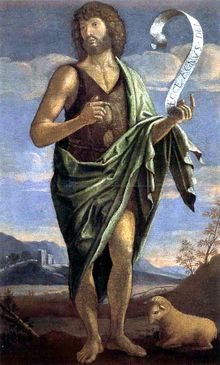 يوحنا المعمدان، رسم Bartolomeo Veneto، القرن 17 | |
| نبي، شهيد، وقديس | |
| وُلِد | أواخر القرن الأول ق.م. Herodian Judea |
| توفي | 31 – 36 م[1][2][3][4] Machaerus, Perea |
مكرّم في | المسيحية الإسلام البهائية المندائية |
| Canonized | Pre-Congregation |
| الضريح الرئيسي | Church of St John the Baptist, Jerusalem Tomb of Prophet Yahya, Umayyad Mosque, Damascus |
| عيده | 24 يونيو (الميلاد)، 29 أغسطس (قطع رأسه)، 7 يناير(Synaxis، الأرثوذكسية الشرقية)، 2 توت (الكنيسة القبطية الأرثوذكسية) |
| الصفات | Camel-skin robe, cross, lamb, scroll with words "Ecce Agnus Dei", platter with own head, pouring water from hands or scallop shell |
| يرعى | Patron saint of Jordan, Puerto Rico, Knights Hospitaller of Jerusalem, French Canada, Newfoundland, Cesena, Florence, Genoa, Monza, Perth (Scotland), Porto, San Juan, Turin, Xewkija, and many other places. |
في المسيحية يوحنا المعمدان هو من عمّد يسوع المسيح في نهر الأردن.
ولد القديس يوحنا المعمدان من والدين تقيين وهما زكريا الكاهن وإليصابات[5] ويذكر التقليد المسيحي عين كارم على أنها موطن زكريا وأليصابات أبوي يوحنا المعمدان سابق المسيح[6]. وهو النبي يحيى بن زكريا لدى الديانة الإسلامية ونبي الديانة الصابئية المندائية لدى الصابئة حيث ينسب له كتاب دراشة أد يهيا (تعاليم يحيى) وهو أحد الكتب المقدسة في الديانة المندائية، كما أن يحيى أو يوحنا المعمدان أو يحيى بن زكريا يعتبر نبياً حسب الديانة البهائية.
المسيح يطلب من يوحنا أن يعمده
في المسيحية كان يوحنا المعمدان يعمّد الناس اي يغسلهم في نهر الأردن للتوبة من الخطايا.
لما بلغ السيد المسيح سن الثلاثين ذهب لنهر الأردن وإعتمد من يوحنا المعمدان »حِينَئِذٍ جَاءَ يَسُوعُ مِنَ الْجَلِيلِ إِلَى الْأُرْدُنِّ إِلَى يُوحَنَّا لِيَعْتَمِدَ مِنْهُ. وَلكِنْ يُوحَنَّا مَنَعَهُ قَائِلاً: »أَنَا مُحْتَاجٌ أَنْ أَعْتَمِدَ مِنْكَ، وَأَنْتَ تَأْتِي إِلَيَّ!« فَقَالَ يَسُوعُ لَهُ: » اسْمَحِ الْآنَ، لِأَنَّهُ هكَذَا يَلِيقُ بِنَا أَنْ نُكَمِّلَ كُلَّ بِرٍّ«. حِينَئِذٍ سَمَحَ لَهُ. فَلَمَّا اعْتَمَدَ يَسُوعُ صَعِدَ لِلْوَقْتِ مِنَ الْمَاءِ، وَإِذَا السَّمَاوَاتُ قَدِ انْفَتَحَتْ لَهُ، فَرَأَى رُوحَ اللّهِ نَازِلاً مِثْلَ حَمَامَةٍ وَآتِياً عَلَيْهِ، وَصَوْتٌ مِنَ السَّمَاوَاتِ قَائِلاً: » هذَا هُوَ ابْنِي الْحَبِيبُ الَّذِي بِهِ سُرِرْتُ« (متى 3:13-17)[7].
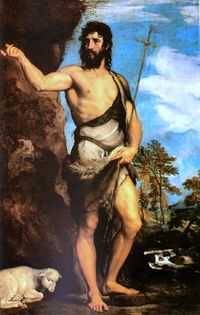
قطع رأسه
تزوج الملك هيرودس من هيروديا زوجة أخيه. وكان هيرودس يخاف يوحنا إذ قال له بأنه لايجوز زواجه بزوجة أخيه فهذا لايحل له. لذلك، سجن هيرودس يوحنا وكانت هيروديا حاقدة على يوحنا من ذلك وفي عيد ميلاد المك هيرودس دعا العظماء والقواد لعشاء فاخر ودخلت ابنة هيروديا لترقص فسرّ هيرودس الملك والمتكئين معه وقال الملك لها أطلبي ما تشائين وسوف يتحقق حتى ولو نصف مملكتي وأقسم على هذا أمام الجمع فخرجت الصبية لعند أمها وتشاورت معها وطلبت رأس يوحنا المعمدان على طبق فحزن الملك جداً لأجل القسم. وأرسل الملك سيافاً وأمره أن يأتي برأس يوحنا. وأتي برأسه للصبية، والصبية بدورها أعطته لأمها [5].
رفاته
Religious views
Christianity
Old Testament as prophesying John
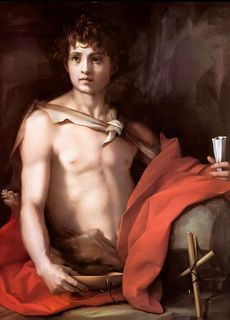

Eastern Orthodox Church
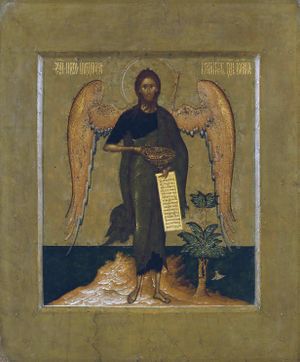
Catholic Church

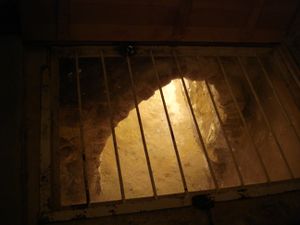
The Roman Catholic Church commemorates St. John the Baptist on two feast days:
- June 24 – Nativity of St. John the Baptist
- August 29 – Beheading of St. John the Baptist
Islam
Prophet Yahya Prophet, Seer, Messenger, Forerunner of Jesus | |
|---|---|
 Prophet Yahya's Shrine inside the Umayyad Mosque, Damascus | |
| وُلِدَ | 6 BCE |
| توفي | 28 CE |
| المثوى | Umayyad Mosque, Damascus |
| أسماء أخرى | New Testament: John the Baptist |
| عـُرِف بـ | Being a gift from God to his father Zachariah, Prophesying with the scripture, Attaining wisdom in youth |
| الوالدان | Zachariah and Elizabeth |
| الأقارب | Cousin of Jesus, Nephew of Mary |
John is also honored as a prophet in Islam as Yaḥyā ibn Zakarīyā (العربية: يحيى بن زكريا), or "John, son of Zechariah". He is believed by Muslims to have been a witness to the word of God, and a prophet who would herald the coming of Jesus.[8] His father Zechariah was also an Islamic prophet. Islamic tradition maintains that John was one of the prophets whom Muhammad met on the night of the Mi'raj,[9] his ascension through the Seven Heavens. It is said that he met John and Jesus in the second heaven, where Muhammad greeted his two 'brothers' before ascending with archangel Gabriel to the third heaven. John's story was also told to the Abyssinian king during the Muslim refugees' Migration to Abyssinia.[10] According to the Qur'an, John was one on whom God sent peace on the day that he was born and the day that he died.[11]
In the Qur'an
In the Qur'an, God frequently mentions Zechariah's continuous praying for the birth of a son. Zechariah's wife, mentioned in the New Testament as Elizabeth, was barren and therefore the birth of a child seemed impossible.[12] As a gift from God, Zechariah (or Zakariya) was given a son by the name of "Yaḥya", a name specially chosen for this child alone. In accordance with Zechariah's prayer, God made John and Jesus, who according to exegesis was born six months later,[13] renew the message of God, which had been corrupted and lost by the Israelites. As the Qur'an says:
(His prayer was answered): "O Zakariya! We give thee good news of a son: His name shall be Yahya: on none by that name have We conferred distinction before."
He said: "O my Lord! How shall I have a son, when my wife is barren and I have grown quite decrepit from old age?"
He said: "So (it will be) thy Lord saith, 'that is easy for Me: I did indeed create thee before, when thou hadst been nothing!'"
(Zakarya) said: "O my Lord! give me a Sign." "Thy Sign," was the answer, "Shall be that thou shalt speak to no man for three nights."
Festivity
In many Mediterranean countries, the summer solstice is dedicated to St. John. The associated ritual is very similar to midsummer celebrations in the Anglo-Saxon tradition.
Locations, churches, and other establishments in his name


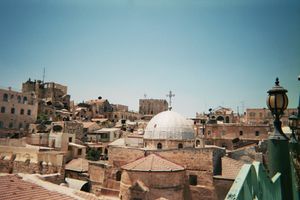
See also
- Biblical and Quranic narratives
- Chronology of Jesus
- Historical background of the New Testament
- Legends and the Quran
- Matthew 3:1
- Messengers from John the Baptist
- Prophets in Islam
- Qisas Al-Anbiya Stories of The Prophets
مراجع
- ^
Metzger, Bruce Manning (1993). The Oxford Companion to the Bible. Oxford University Press. p. 283.
Herod beheaded John at Machaerus in 31 or 32 CE.
- ^
Metzger, Bruce M.; Michael D. Coogan (2004). The Oxford Guide to People & Places of the Bible. Oxford University Press. p. 103.
Herod beheaded John at Machaerus in 31 or 32 CE.
{{cite book}}: CS1 maint: multiple names: authors list (link) - ^ Kokkinos, The Herodian Dynasty, pp. 268, 277.
- ^ Goldberg, G. J (2001) "John the Baptist and Josephus" – "Having said that, it does appear that Josephus is giving John's death as occurring in 36 CE, which is at least 6 years later than what is expected from the New Testament, and after the crucifixion of Jesus."
- ^ أ ب Mhabatzaidal
- ^ AynKarm
- ^ Kalimatalhayat
- ^ "Yahya", Encyclopedia of Islam
- ^ Ibn Ishaq, Sirat Rasul Allah, Mi'raj
- ^ Muhammad, Martin Lings, Abysinnia. etc.
- ^ القرآن 19:13–15
- ^ Lives of the Prophets, Leila Azzam, John and Zechariah
- ^ A–Z of Prophets in Islam and Judaism, B. M. Wheeler, John the Baptist
- ^ القرآن 19:7–10
- ^ Kharatyan, Lusine; Keskin, Ismail; Keshishyan, Avetis; Ozturk, S. Aykut; Khachatryan, Nane; Albayrak, Nihal; Hakobyan, Karen (2013). Moush, sweet Moush: Mapping Memories from Armenia and Turkey (PDF). The Institute for International Cooperation Of the German Adult Education Association (dvv international). p. 69. ISBN 978-3-942755-12-2. Archived from the original (PDF) on January 3, 2015.
The Saint Karapet Monastery is one of the oldest Armenian monasteries in Moush Valley, dating back to the 4th century when Gregory the Illuminator, founder of the Armenian Apostolic Church, is believed to have buried the relics of Saint John the Baptist (Karapet) here.
- ^ Avetisyan, Kamsar (1979). "Տարոնի պատմական հուշարձանները [Historical monuments of Taron]". Հայրենագիտական էտյուդներ [Armenian studies sketches] (in الأرمنية). Yerevan: Sovetakan Grogh. p. 204.
...ըստ ավանդության, Գրիգոր Լուսավորիչը ամփոփել է ս. Կարապետի և Աթանագինե եպիսկոպոսի նշխարները։
{{cite book}}: Check|authorlink=value (help)
وصلات خارجية
 Media related to John the Baptist at Wikimedia Commons
Media related to John the Baptist at Wikimedia Commons- Catholic Encyclopedia: St. John the Baptist
- Jewish Encyclopedia: John the Baptist
- Prophet John (Yahya)
- Mandaean Book of John translation project
- . The American Cyclopædia. 1879.
- St. John the Baptist at the Christian Iconography web site
- Caxton's translation of the Golden Legend chapters on The Decollation of John the Baptist and The Nativity of St. John Baptist
- CS1 الأرمنية-language sources (hy)
- Articles with hatnote templates targeting a nonexistent page
- Missing redirects
- Articles containing explicitly cited عربية-language text
- Pages with empty portal template
- Wikipedia articles incorporating a citation from The American Cyclopaedia
- Wikipedia articles incorporating a citation from The American Cyclopaedia with a Wikisource reference
- John the Baptist
- 0s BC births
- 30s deaths
- 1st-century Christian saints
- 1st-century Romans
- Apocalypticists
- Baptism
- Elijah
- جدالات متعلقة باليهودية
- Mandaeism
- People in the canonical gospels
- أشخاص مشاهير في التقويم الديني اللوثري
- Prophets in Christianity
- Prophets of Islam
- Roman-era Jews
- Biblical figures in Islam
- Saints from the Holy Land
- Saints of the Golden Legend
- World Digital Library related
- Precursors in religion
- قديسون أرثوذكس شرقيون
- شخصيات من العهد الجديد
- رجال دين
- أنبياء ورسل بحسب المعتقد المسيحي
- قديسون في الكنيسة الكاثوليكية
- قديسون في الكنيسة الأرثوذكسية الشرقية
- قديسون في الكنائس الأرثوذكسية المشرقية
- قديسون من الأراضي المقدسة
- وفيات 30
- أشخاص أعدموا بقطع الرأس
